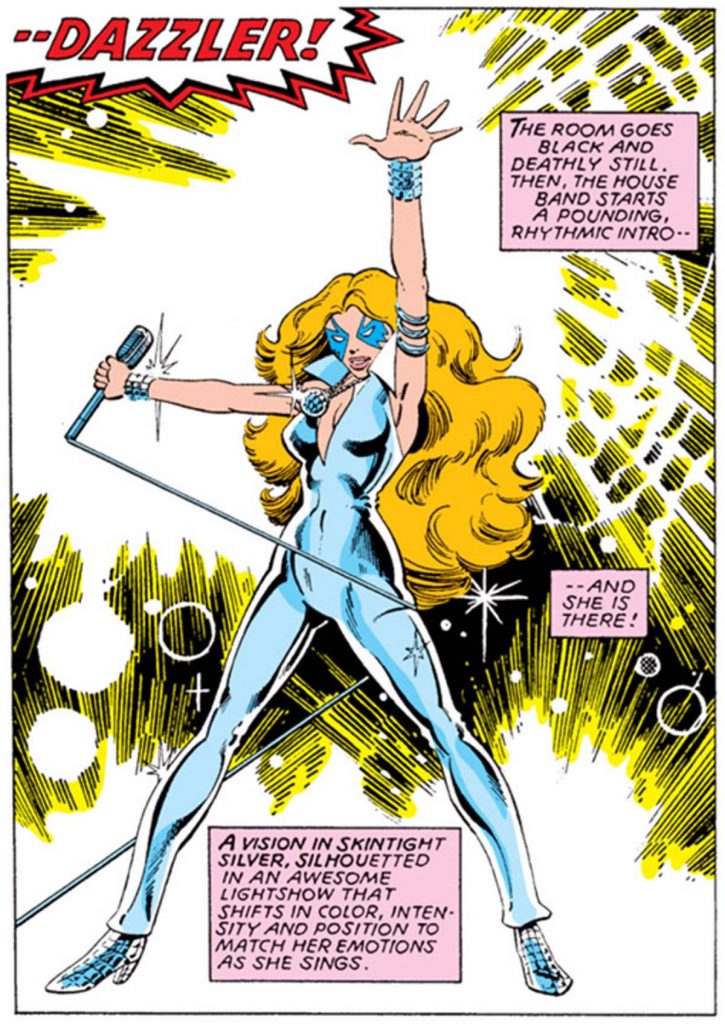First, let’s talk movies. In 1979, Bo Derek was a pinup movie star on the strength of the movie 10.
Next, let’s talk music and comics. Disco was queen in the late 70s. So was the band KISS, who first appeared in a Marvel comic in 1977’s Howard the Duck #12, which led to blood being drawn from each band member that was poured into the vats of red ink used for printing upcoming KISS comics, because of course it was.
Finally, let’s talk about what all that looks like after it is put into a blender. “The Disco Queen” was commissioned by Casablanca Records in 1978 as an animated special to be part a multi-media cross-promotion. Marvel Comics would develop a singing superhero, while Casablanca would produce a singer.
Writer Tom DeFalco was the lead writer behind the comic character, while artist John Romita Jr. provided art and design. The character’s name was changed from The Disco Queen to Dazzler.

Marvel Comics editor-in-chief Jim Shooter wrote a treatment for the animated special, which quickly turned into a live-action feature-length film project. And Shooter wrote the heck out of it, to say the least. The 12-page treatment was wonderfully weird, wild, and wacky. It was to feature Cher, Donna Summers, Robin Williams, Rodney Dangerfield, The Village People, Lenny and Squiggy, and the rock band KISS.
Film studio representatives attached model and actress Bo Derek to the project as Dazzler and insisted that the comic character design reflect Derek’s features. Bo Derek’s controversial husband, John Derek, insisted that he would be the director of the movie. The film studio refused and the entire project was shuttered.
What does that bonkers story have to do with comic book shops? Well, Jim Shooter – never a man to let work go to waste – needed an exclusive title for the burgeoning direct market.
Comic books had been sold on newsstands alongside newspapers and magazines for their entire history, but that had begun to change in the 70s. Speciality shops had begun to emerge, small little stores that focused just on comic books that were the precursors of the friendly local comic shops (FLCS) that us nerds love today.
Although comic books were still being sold on newsstands, this burgeoning “direct market” was slowly growing. But it needed a catalyst.
That catalyst was Dazzler #1 in 1981.

Although its popularity was waning, disco was still thumping at that time. Like a scene straight out of Saturday Night Fever, virtually every bar or nightclub with a dance floor played disco. Dazzler had light powers, so was able to provide her own light show. It was perfect.
Dazzler had the look, the power set, and also cultural relevance. Alison Blaire aka Dazzler was a disco singer who had honed her powers to build herself a singing career, yet her father objected, treating her badly because he disapproved of her career as well as her very existence as a mutant. As a result, Alison actively hid her identity as a mutant, which gives an indication of why gay readers have been some of Dazzler’s most loyal fans throughout the character’s existence.
All of this helped bring readers to the title, and being that it was direct market exclusive, those readers had to come into comic shops to get it, helping the burgeoning niche flourish.
Jim Shooter has an exact number for how much Dazzler #1 helped the early comic shop scene grow. That direct-market only comic book had orders of 428,000 copies. It was ironic, he said, because Dazzler #1 was chosen because a new, untried character had been deliberately chosen for the test so as not to antagonize Marvel’s newsstand accounts. Yet the enormous orders that the title received served to underscore even further the enormous potential the emerging comic shop market had.
The Dazzler series lasted 42 issues and was shortly followed by other direct market-only titles such as Ka-Zar, Micronauts, and Moon Knight. The character went on to be featured off and on for decades, perhaps most memorably in Chris Claremont‘s Australia Era of the X-Men and a lovely Christmas special, where Allison developed her romance with the lucky Longshot.
Dazzler #1 was the first all-direct comic book from a major publisher and it sold 428,000 copies, being integral in ushering in the four-decades-long-existence of the comic book shops us nerds love to this day. Not bad for a mutant created to sell disco records.

